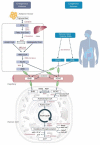The Evolution of Ketosis: Potential Impact on Clinical Conditions
- PMID: 36079870
- PMCID: PMC9459968
- DOI: 10.3390/nu14173613
The Evolution of Ketosis: Potential Impact on Clinical Conditions
Abstract
Ketone bodies are small compounds derived from fatty acids that behave as an alternative mitochondrial energy source when insulin levels are low, such as during fasting or strenuous exercise. In addition to the metabolic function of ketone bodies, they also have several signaling functions separate from energy production. In this perspective, we review the main current data referring to ketone bodies in correlation with nutrition and metabolic pathways as well as to the signaling functions and the potential impact on clinical conditions. Data were selected following eligibility criteria accordingly to the reviewed topic. We used a set of electronic databases (Medline/PubMed, Scopus, Web of Sciences (WOS), Cochrane Library) for a systematic search until July 2022 using MeSH keywords/terms (i.e., ketone bodies, BHB, acetoacetate, inflammation, antioxidant, etc.). The literature data reported in this review need confirmation with consistent clinical trials that might validate the results obtained in in vitro and in vivo in animal models. However, the data on exogenous ketone consumption and the effect on the ketone bodies' brain uptake and metabolism might spur the research to define the acute and chronic effects of ketone bodies in humans and pursue the possible implication in the prevention and treatment of human diseases. Therefore, additional studies are required to examine the potential systemic and metabolic consequences of ketone bodies.
Keywords: anti-inflammatory; beta-hydroxybutyrate; evolution; ketogenesis.
Conflict of interest statement
The authors declare no conflict of interest.
Figures





References
-
- Rowe P., O’Neill C., DeWitt E., Kolwicz S.C. Endurance Exercise Capacity and Substrate Metabolism in Male and Female Mice. FASEB J. 2019;33:698.1. doi: 10.1096/fasebj.2019.33.1_supplement.698.1. - DOI
Publication types
MeSH terms
Substances
LinkOut - more resources
Full Text Sources
Other Literature Sources

